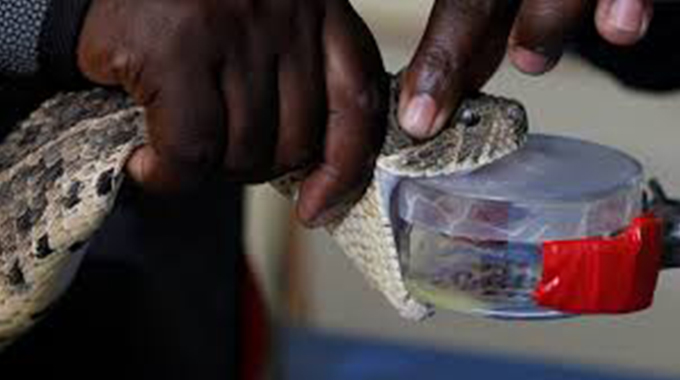Dealing with snake bites

The rains have been good, and a bumper harvest is promising.
As we tend to our fields there are a few crawlies that lurk in the long grass and weeds, that if threatened can render nasty bites.
Snakes: these are the most mysterious cold-blooded, feared creatures.
Snakebites show a classical seasonal variation, being more common in summers and in the rainy seasons (November to April), which are associated with agricultural activities.
The majority of snakes do not bite without provocation; most bites are inflicted when the snakes are inadvertently trodden upon.
Snakebites may be termed an occupational hazard.
People with specific jobs are also more at risk of getting bitten, including:
· Agricultural workers
· Herders
· Fishermen
· Hunters
There are more males, and most are bitten between dusk and dawn (18:00 and 06:00), on the lower limb.
Fortunately, most of bites by venomous snakes are “dry bites” that result in negligible envenomation.
Dry bites occur when a snake doesn’t release any venom with its bite.
Venomous bites are much more dangerous.
They occur when a snake transmits venom during a bite.
Zimbabwe poisonous snakes belong to four families: Colubrids (Boomslang), Vipers (Puff Adder), Elapids (Mambas and Cobras) and Atractaspids (Bibron Stilleto snake).
The Puff Adder is responsible for three quarters of the bites. The majority of snake bites occurred on the lower limb, with most of the remainder occurring on the upper limb.
Snake venoms, are broadly categorised as;
· Cytotoxins: Cause swelling and tissue damage wherever you’ve been bitten.
· Haemorrhagins: Disrupt the blood vessels.
· Anti-clotting agents: Prevent the blood from clotting.
· Neurotoxins: Cause paralysis or other damage to the nervous system.
· Myotoxins: Break down muscles.
Patients are encouraged to take a picture of the snake if it is safe to do so and it does not delay transport to the hospital.
Identifying the species of snake can be helpful if it expedites treatment.
Determine the time of the bite and what signs and symptoms have developed.
The following are the most common symptoms of venomous snakebites:
·Pain, Swelling, Rapid pulse, Fever , Vomiting, Bloody wound discharge, Excessive bleeding and difficulty with clotting of blood, Fang marks in the skin and swelling at the site of the bite, a larger distance between fang puncture wounds suggest a bite by a larger snake, Discoloration, such as redness and bruising, Enlarged lymph nodes in the area affected, Diarrhoea, Burning, Convulsions, Fainting, Dizziness, Weakness, Blurred vision, Excessive sweating, Fever, Increased thirst, Loss of muscle coordination, Numbness and tingling, especially in the mouth, Altered mental state, Shock, Paralysis, Breathing difficulties
Spitting cobra venom when African (N. nigricollis) or Asian spitting cobra (N. n. sputatrix) venom enters the eyes, a very painful reaction results; the venom is not absorbed sufficiently to cause systemic symptoms.
The patient’s head should be rapidly immersed in water, and the patient told to blink; the venom will thus be quickly diluted, and no further ill effects should ensue.
First aid of a snake bite victim: –
1. Remove any jewelry or watches, as these could cut into the skin if swelling occurs.
2. Keep the area of the bite below the heart in order to slow the spread of venom through the bloodstream. Some people fear that elevation can accelerate systemic absorption of the venom, but there is no evidence demonstrating this occurs.
3.Remain still and calm, reassure the victim, most snakebites are nonvenomous.
If you can, roll over to your side and rest in the recovery position.
Moving around a lot will cause the venom to spread faster through the body.
4. Cover the bite with a clean, dry bandage.
Tight arterial compression is not recommended.
Do not:
· pick up the snake or try to trap it.
NEVER handle a venomous snake, not even a dead one or its decapitated head.
· wait for symptoms to appear if bitten, get medical help right away.
· apply a tourniquet.
· slash the wound with a knife or cut it in any way.
· try to suck out the venom.
· apply ice or immerse the wound in water.
· drink alcohol as a painkiller.
· take pain relievers (such as aspirin, ibuprofen, naproxen).
· apply electric shock or folk therapies.
Morbidity and mortality depend on the age and size of victim (children receive larger envenomation relative to body size) as well as comorbid conditions (elderly patients succumb more easily to snake venom).
Patients bitten on the trunk, face, and directly into bloodstream have a worse prognosis.
With envenomation, antivenom can be used to save the life the victim.
Antivenoms are created by immunizing horses or sheep with the venom of a particular snake.
Their blood serum (the watery part of the blood) is then processed, as it will contain antibodies capable of neutralizing the effects of venom.
There are antivenoms that treat bites from a specific type of snake (monospecific antivenoms) and also those that treat bites from a number of snakes found in a particular geographic region (poly-specific antivenoms).
The antivenoms we have are polyvalent. They cover for most of the snake bites we meet in Zimbabwe.
Keep the space around your house tidy and be careful when you pick your wood to prevent snakebites.
Dr Tatenda Simango can be contacted on [email protected] or follow him on Facebook@ 9th Avenue Surgery.











Comments